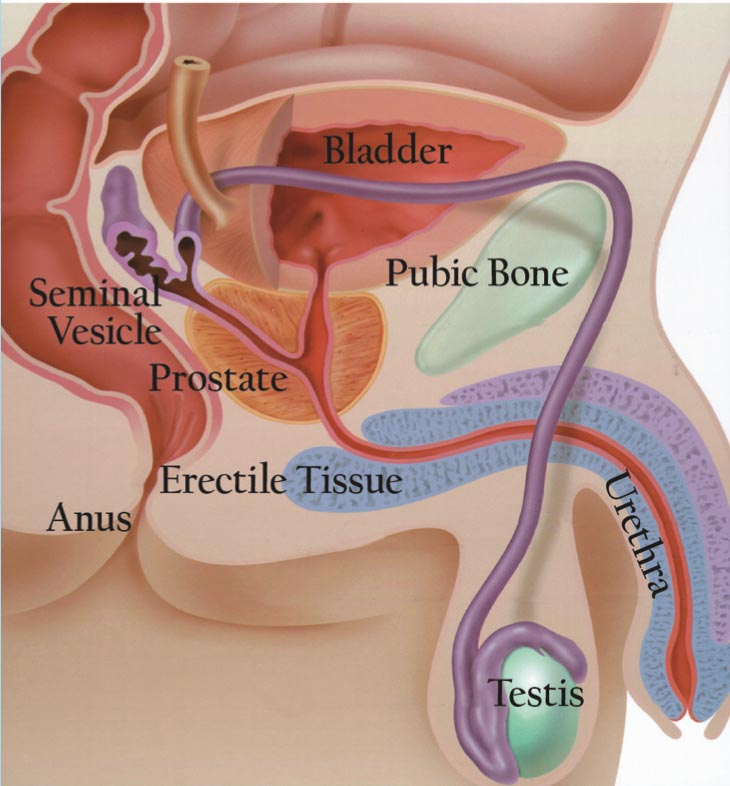PROSTATE CANCER FACTS

What Are Some Prostate Cancer Facts I Should Know?
Excluding non-melanoma skin cancers, prostate cancer is the most common cancer in American men. Current American Cancer Society estimates for 2025 indicate:
-
- About 313,780 new cases of prostate cancer
- About 35,770 deaths from prostate cancer
- Roughly 1 in 8 men will be diagnosed during their lifetime
- Risk increases with age and is higher in non-Hispanic Black men. About six in ten cases are diagnosed at 65+, it’s rare under 40, and the typical (median) age at diagnosis is ~68.
- Most men diagnosed do not die from prostate cancer. More than 3.5 million men in the U.S. who have been diagnosed at some point are alive today.
The good news: With earlier detection and modern, nonsurgical treatment options, many men are cured and maintain an excellent quality of life.
Prostate Anatomy
The prostate gland is a walnut-sized structure located in the pelvis. It is sandwiched between the bladder, which is above the gland, and the rectum, which is below. This is why one side of the prostate can be felt during a rectal exam.
The prostate surrounds the upper part of the urethra, the tube that runs from the bladder to the tip of the penis for urination. Its primary function is to secrete a fluid that helps to transport sperm.
ASK THE DOCTOR
CLICK HERE
TREATMENT HOURS
Mon: 6:30am – 5:30pm
Tues: 6:30am – 5:30pm
Wed: 6:30am – 5:30pm
Thurs: 6:30am – 5:30pm
Fri: 6:30am – 5:30pm
Sat: CLOSED
Sun: CLOSED
PAGE: Print | PDF | Email
Prostate Cancer – What are the causes?
The exact causes of prostate cancer are unknown. The risk of developing prostate cancer increases as men age. Ultimately, more than one in six men will develop prostate cancer during their lifetime. Men with a family history of prostate cancer and African-American men may also be at an increased risk. As men continue to live longer and healthier lives, prostate cancer will likely become a more common problem in the 21st century.
What is early-stage or low-risk prostate cancer?
For truly early-stage disease, you must have a very low risk of cancer being outside of your prostate. This risk can be estimated following a review of your records. Generally speaking, several important criteria must all be met. These include:
-
- PSA < 10
- At most, a small nodule felt in the prostate (stage T1-T2A)
- Biopsy showing a Gleason score < 7
The Journal of the American Medical Association recently published a study looking at close to 2,000 men. It showed that for men with low-risk prostate cancer, a prostate seed implant, external radiation, and surgery offered equivalent SUCCESS RATES. These results typically exceed those found with older technologies such as proton beam radiation.
Likelyhood of Cancer Confined to Prostate1
1Partin et al. JAMA; 2477:1445-1451
What is intermediate to high-risk prostate cancer?
Although surgery (radical prostatectomy) is an effective treatment option for early-stage prostate cancer, it becomes less effective as the risk of cancer having spread beyond the prostate increases. It is difficult for surgeons to completely remove the cancer once it has grown beyond the confines of the prostate gland. Several factors can potentially identify patients who are at a higher risk for having cancer outside the prostate.
These can include any of the following:
-
-
- PSA > 10
- A nodule felt to occupy half of the prostate gland or more on physical exam/b>
- A biopsy showing a more aggressive tumor, with a Gleason score > 6
- A biopsy showing cancer invading around the small nerves in the prostate (perineural invasion)
- Multiple positive prostate biopsies
-
What do you do once diagnosed with prostate cancer?
If the biopsy shows the presence of prostate cancer, the next step is to determine how much cancer is present and to make sure that it has not spread. Our prostate cancer experts will expertly review your PSA blood tests, physical exam findings, and biopsy results. Some simple and painless tests such as a CT scan, bone scan, MRI, and possibly a PET scan can help make sure there is no cancer that has spread outside the prostate. Using the above information, we can then calculate the likelihood of the cancer being completely confined to the prostate, has spread beyond the confines of the prostate, or has spread some distance to the lymph glands in the pelvis.
Why is BRCA Important For Prostate Cancer Patients?
Inherited genetic mutations are being uncovered in up to 12% of men with metastatic prostate cancer, primarily in DNA repair genes such as BRCA1, BRCA2, and ATM.
Helping your doctor make the best cancer screening plan for you. People who have a cancer gene mutation may need to start cancer screening earlier than usual, have it more often, or have additional screening for certain types of cancer.
Personalized treatment options may be available. In some cases, genetic test results may tell your doctor if additional treatment option could be considered.
Helping your family members. Knowing if you have a cancer gene mutation can help your family members know if they may have a higher risk for certain cancers, too.
This information, as well as an evaluation of your overall medical condition and well-being, is critical in determining which treatment options will offer you the best chance for a cure.
EXPERT & EXPERIENCED: TALK TO A PROSTATE CANCER TREATMENT EXPERT
Get a second opinion on your prostate cancer treatment options from Florida Center For Prostate Care, your prostate cancer treatment experts.
